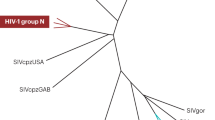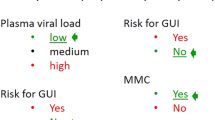Abstract
A 32–nucleotide deletion (δ32) within the β–chemokine receptor 5 (CCR5) gene has been described in subjects who remain uninfected despite extensive exposure to HIV–1. This allele was found to be common in the Caucasian population with a frequency of 0.0808, but was not found in people of African or Asian ancestry. To determine its role in HIV–1 transmission and disease progression, we analyzed the CCR5 genotype of 1252 homosexual men enrolled in the Chicago component of the Multicenter AIDS Cohort Study (MACS). No infected participant was found to be homozygous for the 32 allele, whereas 3.6% of at–risk but uninfected Caucasian participants were homozygous, showing the highly protective role of this genotype against sexual acquisition of HIV–1. No evidence was found to suggest that heterozygotes were protected against HIV–1 infection, but a limited protective role against disease progression was noted. The 32 allele of CCR5 is therefore an important host factor in HIV–1 transmission and pathogenesis.
This is a preview of subscription content, access via your institution
Access options
Subscribe to this journal
Receive 12 print issues and online access
$209.00 per year
only $17.42 per issue
Buy this article
- Purchase on SpringerLink
- Instant access to full article PDF
Prices may be subject to local taxes which are calculated during checkout
Similar content being viewed by others
References
Deng, H. et al. Identification of a major co-receptor for primary isolates of HIV-1. Nature 381, 661–666 (1996).
Dragic, T. et al. HIV-1 entry into CD4 cells is mediated by the chemokine receptor CC-CKR-5. Nature 381, 667–673 (1996).
Alkhatib, G. et al. CC CKR5: A RANTES, MIP-lα, MIP-lβ receptor as a fusion cofactor for macrophage-tropic HIV-1. Science 272, 1955–1958 (1996).
Choe, H. et al. The β-chemokine receptors CCR3 and CCR5 facilitate infection by primary HIV-1 isolates. Cell 85, 1135–1148 (1996).
Doranz, B.J. et al. A dual-tropic primary HIV-1 isolate that uses fusin and the β-chemokine receptors CKR-5, CKR-3, and CKR-2b as fusion cofactors. Cell 85, 1149–1158 (1996).
Feng, Y., Broder, C.C., Kennedy, P.E. & Berger, E.A. HIV-1 entry cofactor: functional cDNA cloning of a seven-transmembrane G protein-coupled receptor. Science 272, 872–877 (1996).
Roos, M.T.L. et al. Viral phenotype and immune response in primary human immunodeficiency virus type 1 infection. J. Infect. Dis. 165, 427–432 (1992).
Wolinsky, S.M. et al. Adaptive evolution of human immunodeficiency virus type 1 during the natural course of infection. Science 272, 537–542 (1996).
Zhu, T. et al. Genotypic and phenotypic characterization of HIV-1 in patients with primary infection. Science 261, 1179–1181 (1993).
Paxton, W.A. et al. Relative resistance to HIV-1 infection of CD4 lymphocytes from persons who remain uninfected despite multiple high-risk sexual exposures. Nature Med. 2, 412–417 (1996).
Liu, R. et al. Homozygous defect in HIV-1 coreceptor accounts for resistance of some multiply-exposed individuals to HIV-1 infection. Cell 86, 367–377 (1996).
Connor, R., Paxton, W.A., Sheridan, K.K. & Koup, R.A. Macrophages and CD4+ T-lymphocytes from two multiply exposed uninfected individuals resist infection with primary NSI isolates of human immunodeficiency virus type 1. J. Virol. (in the press)
Cao, Y., Qing, L., Zhang, L.Q., Safrit, J.T. & Ho, D.D. Virological and immunological characterization of long-term survivors of HIV-1 infection. N. Engl. J. Med. 332, 201–208 (1995).
Connor, R.I., Mohri, H., Cao, Y. & Ho, D.D. Increased viral burden and cytopathicity correlate temporally with CD4+ T-lymphocyte decline and clinical progression in HIV-1 infected individuals. J. Virol. 67, 1772–1778 (1993).
Kaslow, R.A. et al. Influence of combinations of human major histocompatibility complex genes on the course of HIV-1 infection. Nature Med. 2, 405–411 (1996).
Klein, M.R. et al. Associations between HLA frequencies and pathogenic features of human immunodeficiency virus type 1 infection in seroconverters from Amsterdam cohort of homosexual men. J. Infect. Dis. 169, 1244–1249 (1994).
Mellors, J.W. et al. Prognosis in HIV-1 infection predicted by the quantity of virus in plasma. Science 272, 1167–1170 (1996).
Rowland-Jones, S. et al. HIV-specific cytotoxic T-cells in HIV-exposed but uninfected Gambian women. Nature Med. 1, 59–64 (1995).
Samson, M., Labbe, O., Mollereau, C., Vassart, G. & Parmentier, M. Molecular cloning and functional expression of a new human CC-chemokinc receptor gene. Biochemistry 35, 3362–3367 (1996).
Samson, M. et al. Resistance to HIV-1 infection in Caucasian individuals bearing mutant alleles of the CCR-5 chemokine receptor gene. Nature 382, 722–725 (1996).
Dean, M. et al. Genetic restriction of HIV-1 infection and progression to AIDS by a deletion allele of the CKR5 structural gene. Science 273, 1856–1862 (1996).
Chmiel, J. et al. Factors associated with prevalent human immunodeficiency virus (HIV) infection in the Multicenter AIDS Cohort Study. Am. J. Epidemiol. 126, 568–577 (1987).
Mulder, J. et al. Rapid and simple PCR assay for quantitation of human immunodeficiency virus type 1 RNA in plasma: application to acute retroviral infection. J. Clin. Microbiol. 32, 292–300 (1994).
Author information
Authors and Affiliations
Rights and permissions
About this article
Cite this article
Huang, Y., Paxton, W., Wolinsky, S. et al. The role of a mutant CCR5 allele in HIV–1 transmission and disease progression. Nat Med 2, 1240–1243 (1996). https://doi.org/10.1038/nm1196-1240
Received:
Accepted:
Issue Date:
DOI: https://doi.org/10.1038/nm1196-1240



